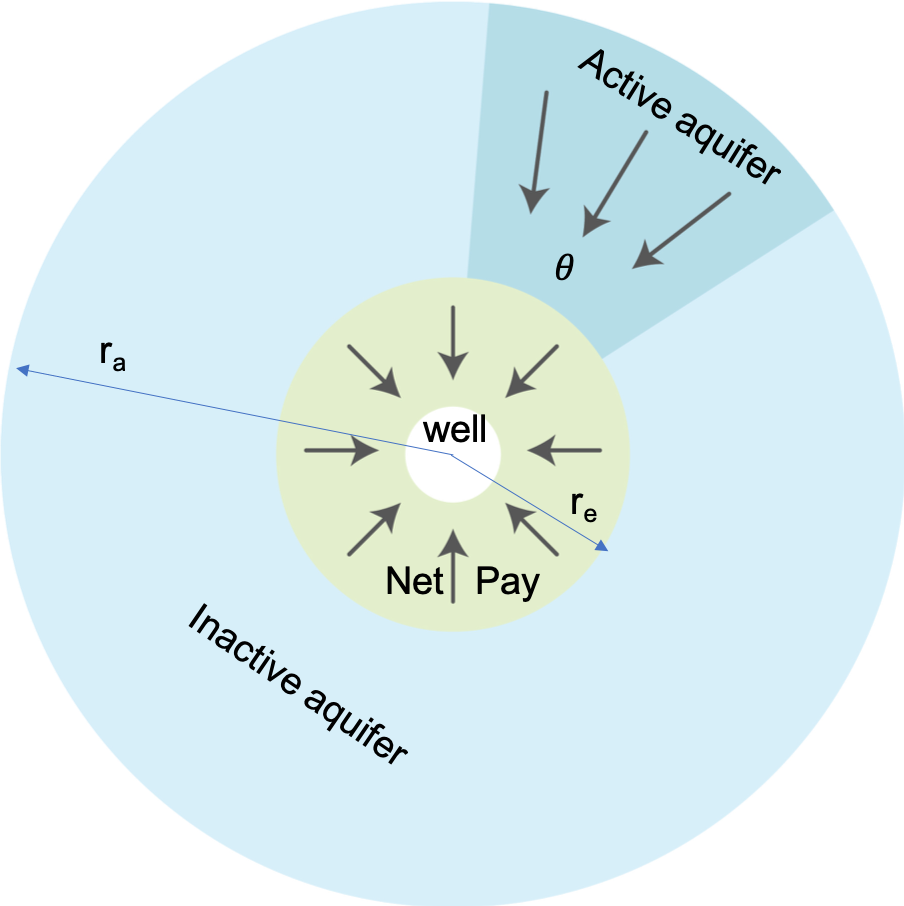You are viewing an old version of this page. View the current version.
Compare with Current
View Page History
« Previous
Version 50
Next »
Motivation
The most accurate way to simulate Aquifer Expansion (or shrinkage) is full-field 3D Dynamic Flow Model where Aquifer Expansion is treated as one of the fluid phases and accounts of geological heterogeneities, gas fluid properties, relperm properties and heat exchange with surrounding rocks.Unfortunately, in many practical cases the detailed information on the aquifer is not available which does not allow a proper modelling of aquifer expansion using a geological framework.
Besides many practical applications require only knowledge of cumulative water influx from aquifer under pressure depletion.
This allows building an Aquifer Drive Models using analytical methods.
Physical Model
Mathematical Model
| (1) |
Q^{\downarrow}_{AQ}= B \cdot \int_0^t W_{eD} \left( \frac{(t-\tau)\chi_a}{r_e^2} \right) \dot p(\tau) d\tau |
|
| (2) |
q^{\downarrow}_{AQ}(t)= \frac{dQ^{\downarrow}_{AQ}}{dt} |
|
| (3) |
W_{eD}(t)= \int_0^{t} \frac{\partial p_1}{\partial r_D} \bigg|_{r_D = 1} dt_D |
| |
| (4) |
\frac{\partial p_1}{\partial t_D} = \frac{\partial^2 p_1}{\partial r_D^2} + \frac{1}{r_D}\cdot \frac{\partial p_1}{\partial r_D} |
| | |
| (7) |
\frac{\partial p_1}{\partial r_D}
\bigg|_{(t_D, r_D=r_a/r_e)} = 0 |
|
Derivation
Transient flow in Radial Composite Reservoir:
| (8) |
\frac{\partial p_a}{\partial t} = \chi \cdot \left[ \frac{\partial^2 p_a}{\partial r^2} + \frac{1}{r}\cdot \frac{\partial p_a}{\partial r} \right] |
| |
| (10) |
p_a(t, r=r_e) = p(t) |
|
| (11) |
\frac{\partial p_a}{\partial r}
\bigg|_{(t, r=r_a)} = 0 |
|
Consider a pressure convolution:
| (12) |
p_a(t, r) = p(0) + \int_0^t p_1 \left(\frac{(t-\tau) \cdot \chi_a}{r_e^2}, \frac{r}{r_e} \right) \dot p(\tau) d\tau |
|
| (13) |
\dot p(\tau) = \frac{d p}{d \tau} |
|
One can easily check that
(12) honors the whole set of equations
(8)–
(11) and as such defines a unique solution of the above problem.
Water flowrate within
\theta sector angle at interface with oil reservoir will be:
| (14) |
q^{\downarrow}_{AQ}(t)= \theta \cdot r_e \cdot h_a \cdot u(t,r_e) |
where
u(t,r_e) is flow velocity at aquifer contact boundary, which is:
| (15) |
u(t,r_e) = M_a \cdot \frac{\partial p_a(t,r)}{\partial r} \bigg|_{r=r_e} |
where
M_a = \frac{k_a}{\mu_w} is aquifer mobility.
Water flowrate becomes:
| (16) |
q^{\downarrow}_{AQ}(t)= \theta \cdot r_e \cdot h_a \cdot M_a \cdot \frac{\partial p_a(t,r)}{\partial r} \bigg|_{r=r_e} |
Cumulative water flux:
| (17) |
Q^{\downarrow}_{AQ}(t) = \int_0^t q^{\downarrow}_{AQ}(t) dt = \theta \cdot r_e \cdot h_a \cdot M_a \cdot \int_0^t \frac{\partial p_a(t,r)}{\partial r} \bigg|_{r=r_e} dt |
Substituting
(12) into
(17) leads to:
| (18) |
Q^{\downarrow}_{AQ}(t) = \theta \cdot r_e \cdot h_a \cdot M_a \cdot \int_0^t d\xi \ \frac{\partial }{\partial r} \left[
\int_0^\xi p_1 \left( \frac{(\xi-\tau)\chi_a}{r_e^2}, \frac{r}{r_e} \right) \, \dot p(\tau) d\tau
\right]_{r=r_e} |
| (19) |
Q^{\downarrow}_{AQ}(t) = \theta \cdot h_a \cdot M_a \cdot \int_0^t d\xi \ \frac{\partial }{\partial r_D} \left[
\int_0^\xi p_1 \left( \frac{(\xi-\tau)\chi_a}{r_e^2}, r_D \right) \, \dot p(\tau) d\tau
\right]_{r_D=1} |
| (20) |
Q^{\downarrow}_{AQ}(t) = \theta \cdot h_a \cdot M_a \cdot \int_0^t d\xi \
\int_0^\xi \frac{\partial p_1}{\partial r_D} \left( \frac{(\xi-\tau)\chi_a}{r_e^2}, r_D \right) \Bigg|_{r_D=1} \, \dot p(\tau) d\tau
|
The above integral represents the integration over the
D area in
(\tau, \ \xi) plane (see Fig. 1):
| (21) |
Q^{\downarrow}_{AQ}(t) = \theta \cdot h_a \cdot M_a \cdot \iint_D d\xi \ d\tau \, \dot p(\tau)
\frac{\partial p_1}{\partial r_D} \left( \frac{(\xi-\tau)\chi_a}{r_e^2}, r_D \right) \Bigg|_{r_D=1}
|
|
Fig. 1. Illustration of the integration
D area in
(\tau, \ \xi) plane |
Changing the integration order from
\tau \rightarrow \xi to
\xi \rightarrow \tau leads to:
| (22) |
Q^{\downarrow}_{AQ}(t) = \theta \cdot h_a \cdot M_a \cdot \int_0^t d\tau \int_\tau^t d\xi \ \dot p(\tau)
\frac{\partial p_1}{\partial r_D} \left( \frac{(\xi-\tau)\chi_a}{r_e^2}, r_D \right) \Bigg|_{r_D=1}
=
\theta \cdot h_a \cdot M_a \cdot \int_0^t \dot p(\tau) d\tau \int_\tau^t d\xi \
\frac{\partial p_1}{\partial r_D} \left( \frac{(\xi-\tau)\chi_a}{r_e^2}, r_D \right) \Bigg|_{r_D=1} |
Replacing the variable:
| (23) |
\xi = \tau + \frac{r_e^2}{\chi_a} \cdot t_D \rightarrow t_D = \frac{(\xi-\tau)\chi_a}{r_e^2} \rightarrow d\xi = \frac{r_e^2}{\chi_a} \cdot dt_D |
and flux becomes:
| (24) |
Q^{\downarrow}_{AQ}(t) = \theta \cdot h_a \cdot M_a \cdot \frac{r_e^2}{\chi_a} \cdot \int_0^t \dot p(\tau) d\tau \int_0^{(t-\tau)\chi_a/r_e^2}
\frac{\partial p_1( t_D, r_D)}{\partial r_D} \Bigg|_{r_D=1} dt_D |
and finally:
| (25) |
Q^{\downarrow}_{AQ}(t) = \theta \cdot h_a \cdot M_a \cdot \frac{r_e^2}{\chi_a} \cdot \int_0^t \dot p(\tau) d\tau \int_0^{(t-\tau)\chi_a/r_e^2}
\frac{\partial p_1( t_D, r_D)}{\partial r_D} \Bigg|_{r_D=1} dt_D |
which leads to
(1) and
(3).
Computational Model
| (26) |
Q^{\downarrow}_{AQ}(t)= B \cdot \sum_\alpha W_{eD}
\left( \frac{ (t-\tau_\alpha) \chi_a}{r_e^2} \right)\Delta p_\alpha |
|
This approach is called superposition in time domain. In practical manual calculations the time step is usually months, rarely years.
See Also
Petroleum Industry / Upstream / Subsurface E&P Disciplines / Field Study & Modelling / Aquifer Drive / Aquifer Drive Models
Reference
1. van Everdingen, A.F. and Hurst, W. 1949. The Application of the Laplace Transformation to Flow Problems in Reservoirs. Trans., AIME 186, 305.
2. Tarek Ahmed, Paul McKinney, Advanced Reservoir Engineering (eBook ISBN: 9780080498836)
3. Klins, M.A., Bouchard, A.J., and Cable, C.L. 1988. A Polynomial Approach to the van Everdingen-Hurst Dimensionless Variables for Water Encroachment. SPE Res Eng 3 (1): 320-326. SPE-15433-PA. http://dx.doi.org/10.2118/15433-PA
